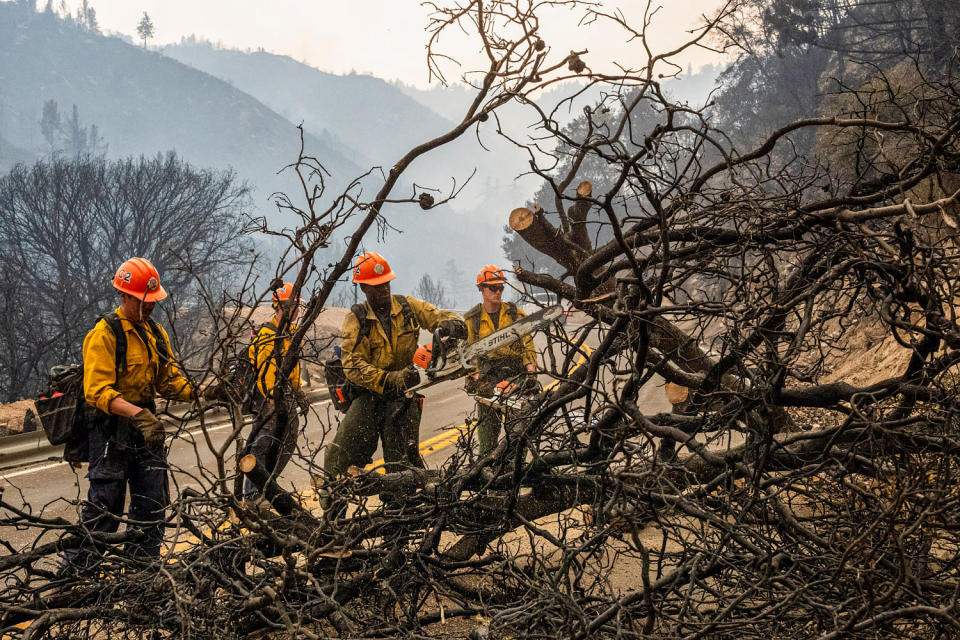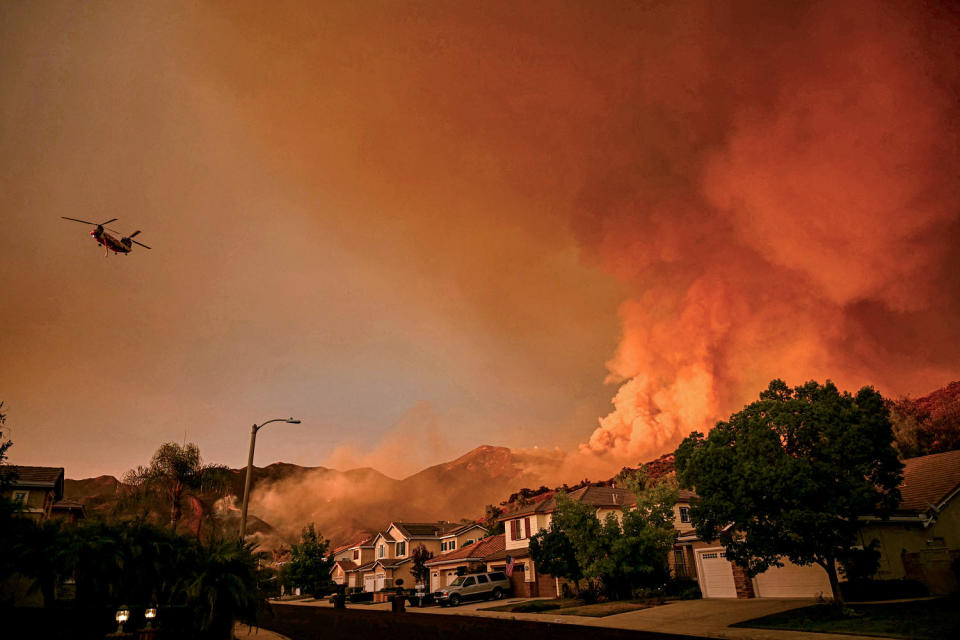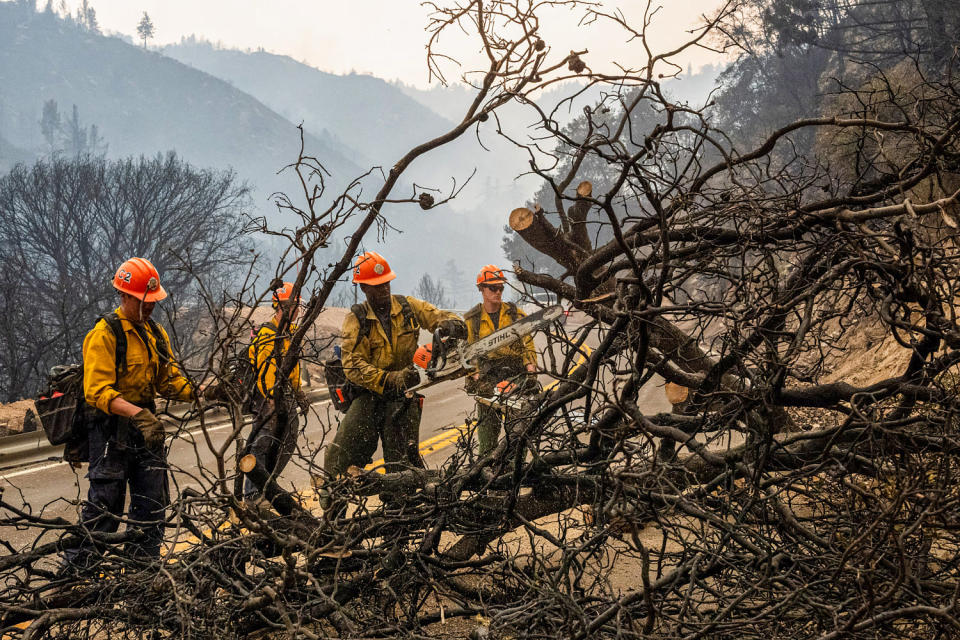Wildfires in California spread rapidly on Tuesday as firefighters faced strong winds, dry conditions and a heat wave that sent temperatures soaring into the triple-digits in the Los Angeles area. Cooler weather in the forecast may soon offer some respite, however.
Firefighters were also battling a fire in hazardous, windy conditions in western Nevada, just south of Reno.
The National Weather service issued red flag warnings for most of Nevada and for parts of Southern California, indicating that large swaths of the landscape were primed to burn.
The fires are an additional strain in what’s already been a busy season for firefighters across the Western U.S. A total of nearly 7 million acres have burned already, which is more than double the area last year. More than 24,000 fire personnel were at work as of Tuesday.
Line Fire in California threatens 65,000 structures
Containment on the the Line Fire, which is burning in the foothills of the San Bernardino National Forest and threatening more than 65,000 homes and other structures, grew to 14% Tuesday.
But its size grew and was around 32,905 acres Tuesday night, according to the California Department of Forestry and Fire Protection (CalFire).

The blaze, which began Thursday night east of Los Angeles, had forced evacuation notices across an area with 9,200 structures, most of them homes, said Arnold Menjivar, a fire information officer.
Menjivar said the fire was burning closest to homes in Running Spring, a gateway community to Big Bear Lake and the Bear Mountain ski resort.
“It’s very close,” Menjivar said, adding that firefighters had an aggressive attack strategy but were concerned about winds gusting through the canyons. “We have very complex terrain out here.”
The Line Fire created its own weather system on Saturday, producing thunderstorm-like pyrocumulus clouds, or fire clouds. These develop when fires are so intense that they generate their own weather patterns. The clouds have been responsible for at least 280 lightning strikes hitting the ground, the National Weather Service said.
Pyrocumulus clouds have also been seen around two other major Southern California fires: the Airport Fire in Orange County and the Bridge Fire in Angeles National Forest.
There have been triple-digit temperatures in a Southern California heat wave, and there had been red flag warnings around the Line Fire Tuesday, but cooler temperatures are expected Wednesday.
That relief could “moderate fire activity and increase fuel moistures,” CalFire said.
Gov. Gavin Newsom issued a state of emergency due to the Line Fire on Saturday. On Monday, fire officials said the California National Guard would deploy four Blackhawk helicopters and other aircraft to aid with modular airborne fire fighting systems, as well as 80 soldiers. Nearly 2,100 fire personnel were responding to the blaze.
Evacuation orders are in place for eastern portions of Highland, California, a suburb of San Bernardino, as well as for several foothills towns on roads up to Big Bear Lake. The Bear Valley Unified and Redlands Unified school districts closed schools Monday and Tuesday due to the fire.
More blazes in Southern California
The hot, dry weather has spurred fires in other Southern California foothill communities as well, forcing additional evacuations.
The Airport Fire started Monday afternoon as a 7-acre brush fire in Orange County’s Trabuco Canyon, south of Los Angeles. In a matter of hours, it had exploded to an estimated 5,400 acres, the OC Fire Authority said. As of Tuesday morning it spanned 9,000 acres, the fire authority said on X.
The blaze was initially reported near an airfield that hobbyists use for remote-controlled planes. On its website, a local flying club called Trabuco Flyers said no remotely controlled aircraft were flying when the fire started.
The fire prompted mandatory evacuations for the communities of Robinson Ranch and the Trabuco Highlands, as well as evacuation warnings in other nearby communities.

Meanwhile, the Bridge Fire sparked on Saturday in the Angeles National Forest, east of Los Angeles, grew from a little under 4,000 acres at 11 a.m. Tuesday to 34,240 acres by Tuesday evening, officials said.
“Tragically, homes have been lost,” San Bernardino County’s government said on Facebook late Tuesday.
The fire is 0% contained, and its cause is under investigation.
An evacuation order is in effect for residents north of the San Antonio Dam up to Mount Baldy Resort, as well as other communities. Wrightwood was also under a mandatory evacuation order Tuesday night.
“There has been substantial wildfire growth throughout the day,” Los Angeles County Fire Chief Anthony Marrone said at a Tuesday evening briefing.
The fire has affected Mount Baldy and the community of Wrightwood, he said. Video shared online by the San Bernardino County Fire Protection District showed firefighters rushing to provide rescues in the community of around 4,700.
The three Southern California wildfires burning at the same time — the Line Fire, the Bridge Fire and the Airport Fire in Orange County — are stretching firefighters thin, and they are asking for help from Northern California and adjoining states, Marrone said.
“We urge everyone who’s under an evacuation order to leave now,” Marrone said at the 7 p.m. PT briefing. Those under evacuation warnings should prepare to leave “at a moment’s notice,” he said.
Dangerous conditions in the Sierra Nevada foothills
Breezy winds and dry conditions put firefighters on high alert near Reno, Nevada, where the Davis Fire had scorched nearly 5,600 acres. It was 0% contained, according to a Tuesday status update.
The fire started around Davis Creek Regional Park, just south of Reno, on Saturday, and was burning heavy timber and brush. It has impacted at least 14 structures, prompted road closures and put some 12,000 to 14,000 people under evacuation notice.
Over 400 personnel are working on the fire. The El Dorado County Fire Protection District shared videos on social media of bright flames burning up wooded mountains and thick plumes of smoke filling the air.
Actor Jeremy Renner was one of the many locals impacted by the Davis fire. On Sunday, he shared an Instagram story depicting a huge smoke cloud billowing from the mountains, People Magazine reported. He shared more photos Tuesday showing firefighters at work and planes dropping pink fire retardant.
Tuesday marks the last day of high temperatures in the areas where the most concerning fires are burning in Nevada and Southern California.
On Wednesday, a cooling flow from the Pacific Ocean is expected to drop temperatures by 10 to 15 degrees Fahrenheit in Southern California.
A cold front is expected to drop into the Reno area on Wednesday, too, but that’s not necessarily good news for the fires because it could enhance winds.
Gusts on mountain peaks could reach 50 mph in wind-prone areas there, according to a National Weather Service forecast.
This article was originally published on NBCNews.com
EMEA Tribune is not involved in this news article, it is taken from our partners and or from the News Agencies. Copyright and Credit go to the News Agencies, email news@emeatribune.com Follow our WhatsApp verified Channel




